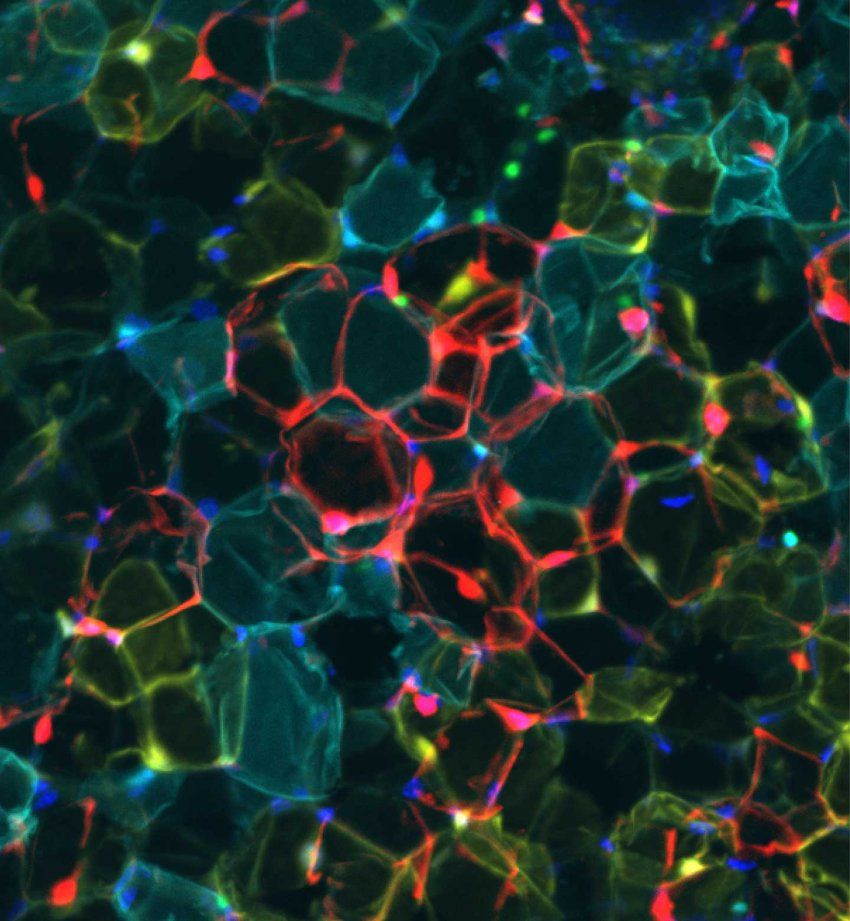Image: Calorie-storing white fat cells. Image Credit: Liang Li.
A new UCSF study shows that suppressing a protein turns ordinary fat into a calorie burner and may explain why drug trials attempting the feat haven’t been successful.
Researchers at UC San Francisco have figured out how to turn ordinary white fat cells, which store calories, into beige fat cells that burn calories to maintain body temperature.
The discovery could open the door to developing a new class of weight-loss drugs and may explain why clinical trials of related therapies have not been successful.
Until now, researchers believed creating beige fat might require starting from stem cells. The new study published July 1 in the Journal of Clinical Investigation, showed that ordinary white fat cells can be converted into beige fat simply by limiting production of a protein.
“A lot of people thought this wasn’t feasible,” said Brian Feldman, MD, PhD, the Walter L. Miller, MD Distinguished Professor in Pediatric Endocrinology and senior author of the study. “We showed not only that this approach works to turn these white fat cells into beige ones, but also that the bar to doing so isn’t as high as we’d thought.”
A fat transformation
Many mammals have three “shades” of fat cells: white, brown, and beige. White fat serves as energy reserves for the body, while brown fat cells burn energy to release heat, which helps maintain body temperature.
Beige fat cells combine these characteristics. They burn energy, and unlike brown fat cells, which grow in clusters, beige fat cells are embedded throughout white fat deposits.
Humans and many other mammals are born with brown fat deposits that help them maintain body temperature after birth. But, while a human baby’s brown fat disappears in the first year of life, beige fat persists.
Humans can naturally turn white fat cells into beige ones in response to diet or a cold environment. Scientists tried to mimic this by coaxing stem cells into becoming mature beige fat cells.
But stem cells are rare, and Feldman wanted to find a switch he could flip to turn white fat cells directly into beige ones.
“For most of us, white fat cells are not rare and we’re happy to part with some of them,” he said.
Of mice and humans
Feldman knew from his earlier experiments that a protein called KLF-15 plays a role in metabolism and the function of fat cells.
With postdoctoral scholar Liang Li, PhD, Feldman decided to investigate how the protein functioned in mice, which retain brown fat throughout their lives. They found that KLF-15 was much less abundant in white fat cells than in brown or beige fat cells.
When they then bred mice with white fat cells that lacked KLF-15, the mice converted them from white to beige. Not only could the fat cells switch from one form into another, but without the protein, the default setting appeared to be beige.
The researchers then looked at how KLF-15 exerts this influence. They cultured human fat cells and found that the protein controls the abundance of a receptor called Adrb1, which helps maintain energy balance.
Scientists knew that stimulating a related receptor, Adrb3, caused mice to lose weight. But human trials of drugs that act on this receptor have had disappointing results.
A different drug targeting the Adrb1 receptor in humans is more likely to work, according to Feldman, and it could have significant advantages over the new, injectable weight-loss drugs that are aimed at suppressing appetite and blood sugar.
Feldman’s approach might avoid side effects like nausea because its activity would be limited to fat deposits, rather than affecting the brain. And the effects would be long-lasting, because fat cells are relatively long-lived.
“We’re certainly not at the finish line, but we’re close enough that you can clearly see how these discoveries could have a big impact on treating obesity,” he said.
-
As with anything you read on the internet, this article should not be construed as medical advice; please talk to your doctor or primary care provider before changing your wellness routine. This article is not intended to provide a medical diagnosis, recommendation, treatment, or endorsement. Additionally, it is not intended to malign any religion, ethnic group, club, organization, company, individual, or anyone or anything. These statements have not been evaluated by the Food and Drug Administration.
Content may be edited for style and length.
References/Sources/Materials provided by:
This article was written by Robin Marks at the University of California-San Francisco
Image: Calorie-storing white fat cells. Image Credit: Liang Li.


